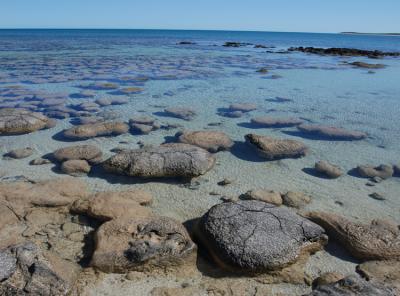What Happened to the Stromatolites, the Most Ancient Visible Lifeforms on Earth?
Stromatolites, or living layerd rocks, turned into thrombolites, or clotted stones, after a unicellular take-over

Stromatolites near Shark Bay in Australia. Photo: Virginia Edgcomb, Woods Hole Oceanographic Institution
In a few scattered places around the world, remnants of some of the planet’s most ancient lifeforms still grow. Stromatolites, also known as layered rocks, form in shallow waters when biofilms of living microorganisms, like cyanobacteria, trap sediment. Most stromatolites grow in extremely salty lagoons or bays, in places like Australia, Brazil, Mexico and the Bahamas.
But it wasn’t always like that. Around 3.5 billion years ago, stromatolites dominated shores around the world and reigned as the Earth’s first visible-to-the-naked-eye life form. Now, scientists think they’ve solved the mystery of what happened to the once profuse stromatolites: a single-celled organisms called foraminifera likely caused the stromatolites’ undoing.
For two billion years, the stromatolites’ place in the ecosystem was unchallenged. But around a billion years ago, the layered rocks abruptly disappeared from the fossil record. Researchers say the extinction is no less dramatic than that of the dinosaurs, yet no one knew what happened to the stromatolites.
At the same time, however, another peculiar rock-like living structure began turning up. Called thrombolites, or clotted stones, these clumpy aggregations were not as fine-layered as the stromatolites but are similarly produced by biofilms of microorganisms.
The researchers of this new study decided to compare modern stromatolites and thrombolites for clues. With genetic sequencing, they found that thrombolites house a large number of foraminifera, a unicellular oceanic microbe. The foraminifera’s evolution coincides with the appearance of thrombolites.
But this wasn’t evidence that these microbes caused the strombolites to decline. To make that connection, the researchers simulated billion-year-old conditions by assembling modern-day stromatolites and foraminifera from thrombolites. After six months, the strombilites’ fine layers had turned into a clumpy, thrombolite-like mess. The researchers suspect that a similar take-over occurred a billion years ago, all over the planet, driving only the most extreme of stromatolites out of existence, or at least turning them into a messy version of their former selves.
More from Smithsonian.com:
/https://tf-cmsv2-smithsonianmag-media.s3.amazonaws.com/accounts/headshot/Rachel-Nuwer-240.jpg)
/https://tf-cmsv2-smithsonianmag-media.s3.amazonaws.com/accounts/headshot/Rachel-Nuwer-240.jpg)